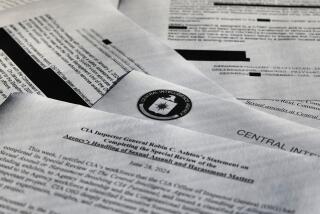CIA Issuing 11 Reprimands in Ames Spy Case
- Share via
WASHINGTON — CIA Director R. James Woolsey announced Wednesday that he is reprimanding 11 current and former senior intelligence officials for their roles in failing to help detect that one of the agency’s employees, Aldrich H. Ames, was spying for the Soviet Union.
But Woolsey is not firing or demoting any of these officials--all but one of whom worked for the CIA’s Directorate of Operations, its clandestine service. Only four of the 11 officials will receive “serious” reprimands. Three of those four have already retired, so the only penalty they will suffer will be a ban on post-retirement work for the CIA.
The current head of the Operations Directorate, Ted Price--who served as head of the CIA’s Counterintelligence Center while Ames worked for it in 1990--was among the seven people given a mild reprimand. But he will keep his job as the CIA official in direct charge of spying and covert operations.
Woolsey’s actions follow the completion of a classified CIA inspector general’s report that found there had been, by Woolsey’s own admission, “a systemic failure of the CIA.”
“The consequences have been horrid for us at the CIA, for the American people and for those who helped us overseas and who, in a number of cases, in effect, were murdered by Ames,” the director admitted.
Rep. Dan Glickman (D-Kan.), chairman of the House Intelligence Committee, said in an interview Wednesday night that he would have liked to see “some heads roll” at the CIA for its mishandling of the Ames case. However, he went on, “the problem is that you’d like to see the right heads roll. . . . Most of the people I see really culpable and responsible are no longer at the agency.”
Ames began spying for the Soviet Union in 1985 and continued until he was arrested early this year. By official estimates, his actions in turning over CIA secrets led to the deaths of 10 people working for U.S. intelligence and compromised about three dozen cases. Yet Ames was left on the job and repeatedly given new assignments in extremely sensitive positions, including the CIA’s Soviet/Eastern Europe division and the Counterintelligence Center.
In a press conference Wednesday, Woolsey acknowledged that Ames’ drinking problem had been so egregious that, at one point while he was stationed in Rome in the 1980s, he fell drunk in a gutter and was retrieved by the Italian police. Yet when he returned from Rome, he was given a job in the Soviet Union/Eastern Europe division at the CIA’s headquarters in Langley, Va.
In 1988, CIA Director William H. Webster established a new Counterintelligence Center in an effort to respond to the spy case of Edgar Lee Howard, a young agent who defected to the Soviet Union. Officials in the Directorate of Operations assigned Ames to the new center in what Woolsey called “an easy solution to what they erroneously thought was no more than a personnel problem.”
With that transfer, Ames won access to the internal CIA computer system that gave details of double-agent cases--people pretending to be spying for the Soviet Union, while actually reporting back to the United States. He passed on the details to the KGB, the Soviet secret police.
Woolsey went to Capitol Hill on Wednesday to try to explain to Congress, in closed-door meetings, what disciplinary actions he is taking as a result of the Ames case. He told reporters he wants to “leave Ames behind . . . and turn our attention resolutely to the future.”
But it is unclear whether Congress will support him. One intelligence specialist, Jeff Richelson of the National Security Archives, said Woolsey’s response will be seen as “clearly insufficient. . . . I’m surprised there were no demotions or firings.”
Yet former CIA Director Richard Helms, himself a former head of the Directorate of Operations, said that Woolsey’s personnel decisions were “reasonable. We don’t really arrest policemen because they don’t catch the burglars.” Although Ames’ work for the KGB resulted in the deaths of 10 people, Helms said, “the fact remains that people get killed around here all the time. Let’s not exaggerate this.”
Woolsey told reporters Wednesday that the 11 current and former intelligence officers were being reprimanded for “errors in management, as well as for failing to devote sufficient resources to the counterintelligence effort as questions arose.” Price was the only one of the 11 people identified by name.
Of the four people to whom the director gave serious reprimands, the only one still at the CIA will retire within the next few days, for reasons Woolsey said were unrelated to the Ames case. All four will be “barred from further relationships with the CIA” during retirement. They will receive their regular pensions.
Of the seven who received milder reprimands, four still work for the CIA and three are retired. Woolsey said those who were reprimanded cannot be given promotions or performance awards for at least two years.
The CIA director said that Price worked as director of the Counterintelligence Center only for a “relatively brief” period of 10 months.
“Those who conducted the mole hunt are explicit that they reported to him only during this period,” Woolsey said. “Neither his superior nor his subordinates were calling for increased resources. . . . I have confidence in Ted Price’s ability and professionalism, and I have asked him to stay on as director of operations.”
After discussing Price’s case at Wednesday’s closed hearing, Glickman said that “as I examine it today, he is not a particularly culpable” individual.
The CIA’s internal investigation turned up a long series of errors and management mistakes in the handling of the Ames case. For example, Ames stopped reporting his meetings with Soviet officials in clear violation of CIA policy, but his superiors took no action against him. When junior officers tried to ask Ames about this, “management dropped the matter, a most serious lack of attention to duty,” Woolsey acknowledged.
At another point, the CIA director said, “Ames, who had been ranked as third from the bottom out of 200 officers, was selected to serve on a promotion panel. . . . In that assignment Ames was in a position to do substantial damage, for he was given easy access to the files of a group of our mid-level officers.”
More to Read
Sign up for Essential California
The most important California stories and recommendations in your inbox every morning.
You may occasionally receive promotional content from the Los Angeles Times.












